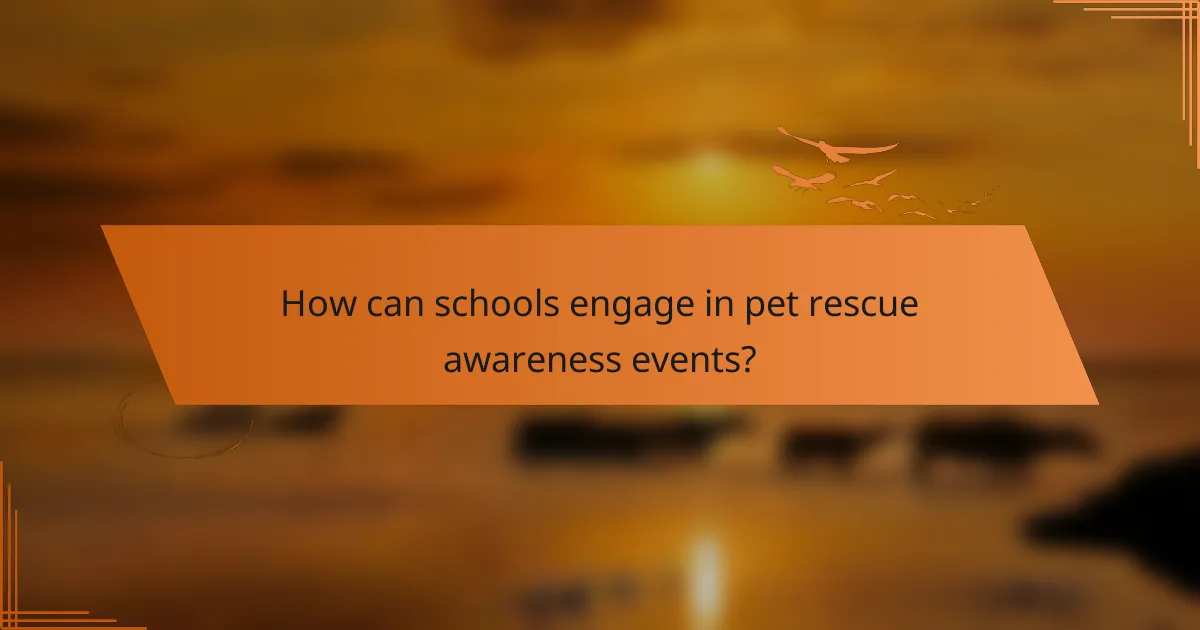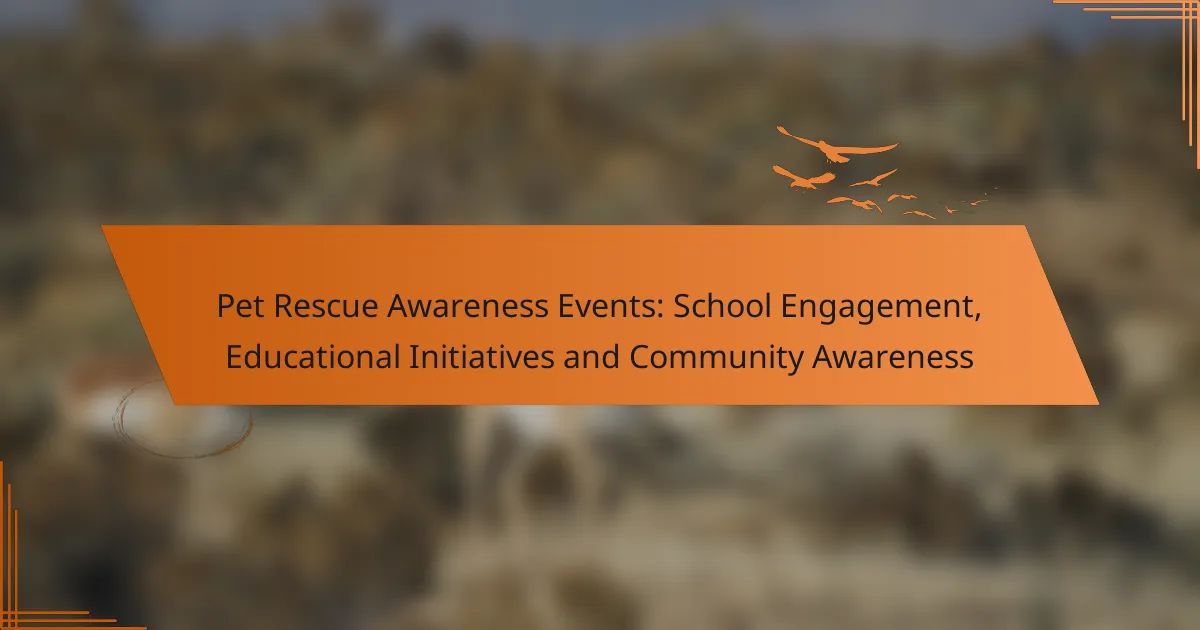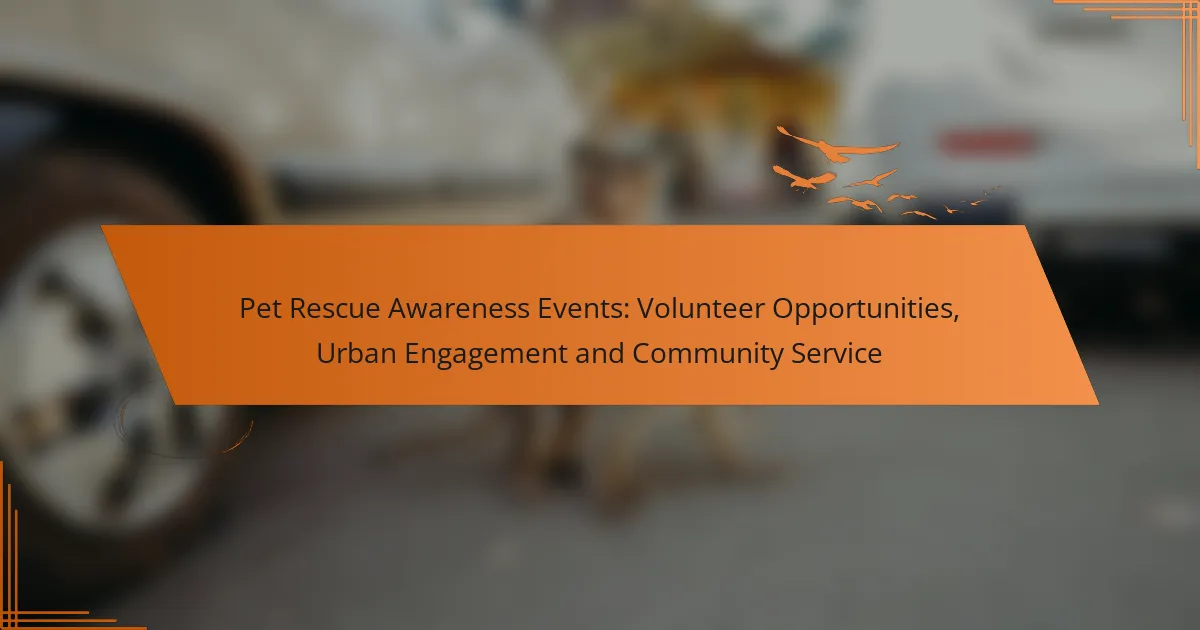Pet rescue awareness events in schools serve as a crucial platform for educating students and the broader community about animal welfare. By engaging students through interactive activities, these initiatives foster empathy and promote responsible pet ownership, while also encouraging community involvement in supporting local rescue organizations.

How can schools engage in pet rescue awareness events?
Schools can play a vital role in pet rescue awareness by organizing events that educate students and the community about the importance of animal welfare. Engaging students through hands-on activities fosters empathy and encourages responsible pet ownership.
Organizing pet adoption days
Pet adoption days provide a platform for local shelters to showcase animals in need of homes. Schools can partner with these shelters to host events on campus, allowing students and families to meet adoptable pets and learn about the adoption process.
Consider scheduling these events during weekends or school fairs to maximize attendance. Providing information on the responsibilities of pet ownership can also help potential adopters make informed decisions.
Hosting educational workshops
Educational workshops can cover various topics related to pet care, such as nutrition, training, and health. Inviting veterinarians or animal behaviorists to speak can enhance the learning experience and provide expert insights.
Workshops can be tailored for different age groups, ensuring that the content is age-appropriate and engaging. Hands-on activities, like basic training demonstrations, can make these sessions more interactive and memorable.
Collaborating with local shelters
Collaboration with local shelters can enhance the effectiveness of pet rescue awareness initiatives. Schools can establish ongoing partnerships that include guest speakers, field trips, and volunteer opportunities for students.
By working closely with shelters, schools can ensure that their programs align with community needs and promote a culture of compassion towards animals. This partnership can also facilitate resource sharing, such as educational materials and promotional support.
Incorporating pet care into the curriculum
Integrating pet care topics into the curriculum can provide students with a deeper understanding of animal welfare. Subjects like biology, ethics, and social studies can include lessons on the importance of rescue and adoption.
Projects such as research assignments on various breeds or creating presentations on responsible pet ownership can engage students while fostering a sense of responsibility towards animals.
Creating student-led awareness campaigns
Student-led campaigns can empower young people to take initiative in promoting pet rescue awareness. Schools can support these campaigns by providing resources and guidance while allowing students to lead the efforts.
Examples include organizing poster contests, social media campaigns, or fundraising events for local shelters. Encouraging creativity and leadership in these projects can significantly increase community engagement and awareness.

What educational initiatives promote pet rescue awareness?
Educational initiatives that promote pet rescue awareness focus on teaching students about animal welfare, responsible pet ownership, and the importance of rescue organizations. These programs engage students through interactive learning experiences that foster empathy and a sense of community responsibility.
Curriculum development on animal welfare
Integrating animal welfare into school curricula helps students understand the importance of caring for pets and the role of rescue organizations. This can include lessons on responsible pet ownership, the impact of overpopulation, and the benefits of adopting pets from shelters.
Schools can collaborate with local animal welfare groups to create age-appropriate materials that align with educational standards. This ensures that students receive accurate information while developing critical thinking skills related to animal care.
Interactive presentations by rescue organizations
Rescue organizations often conduct interactive presentations in schools to engage students directly. These sessions typically include storytelling, videos, and live demonstrations that highlight the work of rescuers and the animals they save.
Such presentations can inspire students to get involved in local rescue efforts, whether through volunteering or organizing fundraising events. Schools should consider scheduling these presentations regularly to maintain awareness and enthusiasm among students.
Field trips to animal shelters
Field trips to local animal shelters provide students with firsthand experience of the rescue process. During these visits, students can learn about the daily operations of shelters, the challenges faced by animals, and the importance of adoption.
These trips can also include hands-on activities, such as helping with basic care tasks or participating in educational workshops. Schools should coordinate with shelters to ensure a safe and informative experience for students.
Guest speakers from veterinary services
Inviting guest speakers from veterinary services can enhance students’ understanding of animal health and welfare. Veterinarians can share insights on the medical needs of pets, the importance of spaying and neutering, and the role of veterinary care in rescue efforts.
These sessions can also address common misconceptions about pet care and encourage students to advocate for animal welfare in their communities. Schools should aim to include a diverse range of speakers to provide varied perspectives on animal care and rescue.

How can communities support pet rescue awareness events?
Communities can support pet rescue awareness events by actively participating in initiatives that promote animal welfare and education. Engaging local residents, businesses, and organizations fosters a collaborative environment that amplifies the message of pet rescue and encourages responsible pet ownership.
Organizing community fundraising events
Fundraising events are a vital way for communities to support pet rescue efforts. These can include charity walks, bake sales, or auctions, where proceeds directly benefit local shelters and rescue organizations. Aim for a variety of activities to attract different demographics, ensuring broad participation.
Consider setting a fundraising goal and promoting it through local media to increase visibility. Additionally, offering incentives, such as prizes for top fundraisers, can motivate more people to get involved.
Creating partnerships with local businesses
Partnering with local businesses can significantly enhance pet rescue awareness events. Businesses can sponsor events, provide venues, or donate goods and services, which helps reduce costs and increases community engagement. In return, businesses gain positive publicity and demonstrate their commitment to social responsibility.
To establish these partnerships, approach businesses with a clear proposal outlining the benefits of collaboration. Highlight how their support can make a tangible difference in the community and for local pets in need.
Utilizing social media for outreach
Social media is a powerful tool for promoting pet rescue awareness events. Platforms like Facebook, Instagram, and Twitter can reach a wide audience quickly, allowing communities to share event details, success stories, and educational content. Regular updates and engaging visuals can help maintain interest and encourage participation.
Consider creating event-specific hashtags to track engagement and encourage attendees to share their experiences. This not only raises awareness but also builds a sense of community around the cause.
Hosting volunteer opportunities
Offering volunteer opportunities is essential for fostering community involvement in pet rescue initiatives. Volunteers can assist with events, help at shelters, or participate in educational programs. This hands-on experience not only supports the cause but also educates volunteers about the importance of animal welfare.
To attract volunteers, clearly outline the roles and responsibilities, and provide training sessions to ensure they feel prepared and valued. Recognizing and appreciating their efforts can also help retain volunteers for future events.

What are the benefits of pet rescue awareness events?
Pet rescue awareness events provide crucial benefits such as increasing adoption rates, fostering community involvement, and enhancing education on animal welfare. These initiatives not only help animals find homes but also create a more informed and engaged community.
Increased adoption rates
Pet rescue awareness events significantly boost adoption rates by showcasing animals available for adoption in a friendly and engaging environment. By bringing potential adopters face-to-face with pets, these events create emotional connections that often lead to quicker decisions to adopt.
For instance, local fairs or community gatherings featuring pet rescue booths can attract hundreds of visitors, resulting in dozens of adoptions. Offering incentives, such as reduced fees or free starter kits, can further encourage attendees to consider adopting a pet.
Enhanced community involvement
These events foster enhanced community involvement by encouraging local residents to participate in activities that support animal welfare. Volunteers can engage in various roles, from organizing the event to caring for the animals, which strengthens community bonds.
Additionally, partnerships with local businesses can create sponsorship opportunities, allowing them to contribute resources or services. This collaboration not only increases visibility for the rescue organizations but also promotes a sense of shared responsibility for animal welfare within the community.
Improved animal welfare education
Pet rescue awareness events serve as an educational platform to inform the public about responsible pet ownership and animal welfare issues. Workshops, demonstrations, and informational booths can cover topics such as proper pet care, the importance of spaying/neutering, and the benefits of adopting over buying pets.
Providing literature and resources during these events can help attendees learn about local regulations regarding pet ownership, fostering a more informed community that prioritizes the well-being of animals.
Strengthened relationships with local shelters
These events help strengthen relationships between pet rescue organizations and local shelters, creating a unified front for animal welfare. Collaboration allows for resource sharing, joint marketing efforts, and a more extensive network for finding homes for pets.
By working together, shelters and rescue groups can coordinate efforts to maximize their impact, such as organizing joint adoption drives or community outreach programs. This synergy enhances the overall effectiveness of their missions and ensures that more animals receive the care and homes they need.

What criteria should schools consider for successful events?
Schools should focus on clear objectives, community involvement, and effective communication when planning pet rescue awareness events. These criteria ensure that events are engaging, informative, and impactful for students and the local community.
Identifying target audience
Understanding the target audience is crucial for the success of pet rescue awareness events. Schools should consider the age groups of students, their interests, and the local community demographics to tailor the event effectively.
For example, younger students may benefit from interactive activities like pet care demonstrations, while older students might engage more with discussions on animal welfare issues. Schools can also involve parents and community members to broaden the reach and impact of the event.
To identify the target audience, schools can conduct surveys or hold focus groups to gather insights on what topics and formats would resonate best. This approach helps ensure that the event meets the needs and interests of all participants.



